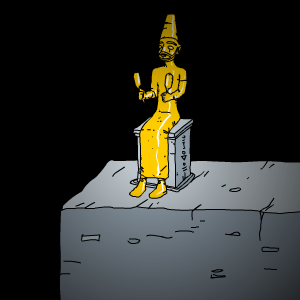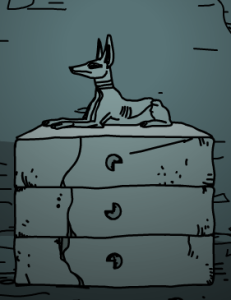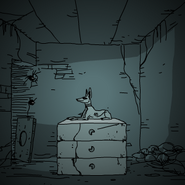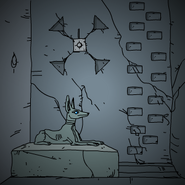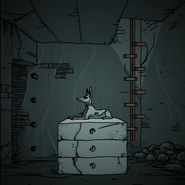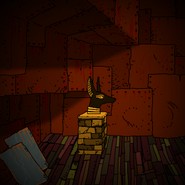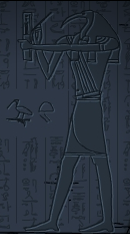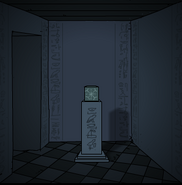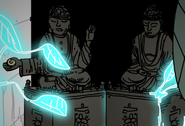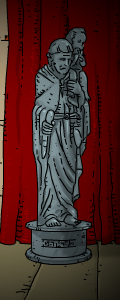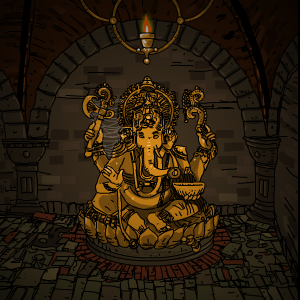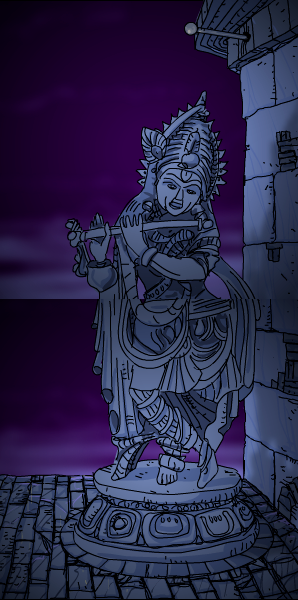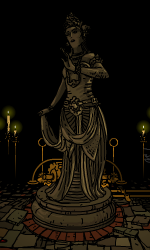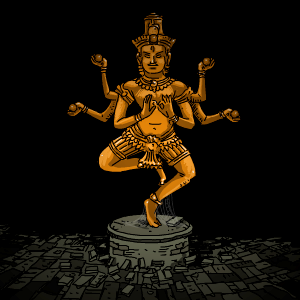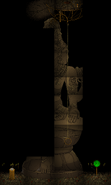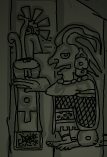Most of the Submachine series games contain at least one reference to various world gods and deities. The gods and deities usually do not contribute significantly to the gameplay, save for Submachine 9: The Temple and Submachine 10: The Exit.
El[]
|
'Ēl
| |
|
Type
|
God
|
|
God of
|
Creation, heaven
|
|
Game appearances
|
|
ʼĒl (or ʼIl, Hebrew: אל; romanized: ilu) is a Northwest Semitic word meaning "god" or "deity", or referring (as a proper name) to any one of multiple major ancient Near Eastern deities.
Specific deities known as ʼEl or ʼIl include the supreme god of the ancient Canaanite religion and the supreme god of East Semitic speakers in Mesopotamia’s Early Dynastic Period. For the Canaanites and the ancient Levantine region as a whole, Ēl or Il was the supreme god, the father of mankind and all creatures. He also fathered many gods, most importantly Hadad, Yam, and Mot, each sharing similar attributes to the Greco-Roman gods: Zeus, Poseidon, and Hades respectively. "El" (Father of Heaven / Saturn) and his major son: "Hadad" (Father of Earth / Jupiter), are symbolized both by the bull, and both wear bull horns on their headdresses.
In the Ugaritic Ba‘al cycle, Ēl is introduced dwelling on (or in) Mount Lel (Lel possibly meaning "Night") at the fountains of the two rivers at the spring of the two deeps. He dwells in a tent according to some interpretations of the text which may explain why he had no temple in Ugarit. As to the rivers and the spring of the two deeps, these might refer to real streams, or to the mythological sources of the salt water ocean and the fresh water sources under the earth, or to the waters above the heavens and the waters beneath the earth.
In the Hebrew Bible, the names Ēl and ’Ĕlōhîm, when used in the singular to mean the supreme god, refer to Yahweh.
A bilingual inscription from Palmyra dated to the 1st century equates Ēl-Creator-of-the-Earth with the Greek god Poseidon.
While Egyptian culture has had its fair share in the Submachine series, not too many actual gods have been shown or mentioned. The only one that has actually been named is Thoth.
Anubis[]
|
Anubis
| |
|
Type
|
God
|
|
God of
|
Mummification, afterlife
|
|
Game appearances
|
|
Anubis or Inpu is the Egyptian god of mummification and afterlife, and originally even Death, though the role as a death god was later transferred to the god Osiris.[1]
Anubis is often depicted as a jackal headed man, or even a full jackal. He is the head embalmer, and is often shown embalming people.
Anubis is the son of Osiris and Nepthys, husband of Anput and the father of Kebetchet. His half-brother is Horus the Younger, son of Osiris and Isis.[2]
In the myth of Osiris and Isis, Anubis helped Isis and Nepthys embalm his dead father. Later he was given his father organs and thus he became the god of embalmers.[3][2]
In the Underworld, Anubis performed the measuring of the heart of the deceased. He put it on a scale and weighed it against the feather of Ma'at. This result was written down by Thoth. This granted him great power in the Underworld, only surpassed by Osiris.[4]
Thoth[]
|
Thoth
| |
|
Type
|
God
|
|
God of
|
knowledge, secrets, writing, and scribes.
|
|
Game apearances
|
|
Thoth or Djehuti is an important Egyptian deity. He is most often depicted with a body of a human and the head of an ibis, however he is sometimes shown as a full ibis or even a baboon. It should be noted that these forms were symbolic to Egyptians, and they didn't actually think their gods had heads of animals. Usually Thoth is shown carrying a scribe's palette and stylus.[5]
Thoth is believed to be the maker of the divine plans for all in the universe, which Ma'at, Thoth's wife, made true. Thoth was also to believed to control the movements of the planets. Thoth also acts as a balance keeper, and makes sure that evil nor good shall ever win in their battle.
The length of the year is also credited to Thoth, as it is told he gambled for the last five days of the year from Khonsu. This was due to Nut's inability to have children on the first 360 days of the year. This is probably the reason he is seen as the measurer of time.[6]
Further more Thoth was the one to give healing spells to Isis when his son Osiris had been cut to pieces, and Horus when he was slain.[7]
Thoth also had the role of a scribe in the underworld, Duat. When the heart of the deceased was weighed against the feather of Ma'at, Thoth wrote down the results.[8][9]
Eye of Horus[]
|
Eye of Horus
| |
|
Type
|
Symbol/Amulet
|
|
Properties
|
Protection, good health
|
|
Game appearances
|
|
The Eye of Horus is an ancient Egyptian symbol of protection, royal power and good health. The eye is personified in the goddess Wadjet. It is also known as The Eye of Ra. The name Wadjet is derived from "wadj" meaning "green", hence "the green one". Wadjet was one of the earliest of Egyptian deities who later became associated with other goddesses such as Bast, Sekhmet, Mut, and Hathor. She was the tutelary deity of Lower Egypt and the major Delta shrine the "per-nu" was under her protection. Hathor is also depicted with this eye.
Funerary amulets were often made in the shape of the Eye of Horus. The Eye of Horus "was intended to protect the pharaoh [here] in the afterlife" and to ward off evil. Ancient Egyptian and Near Eastern sailors would frequently paint the symbol on the bow of their vessel to ensure safe sea travel.[10]
Tonatiuh[]
|
Tonatiuh
| |
|
Type
|
God
|
|
God of
|
Sun, Current era
|
|
Game appearances
|
|
Tonatiuh (Nahuatl: Ollin Tonatiuh, "Movement of the Sun") was the god of the sun and the sky in Aztec mythology. He is frequently depicted wearing clothing of a king.
Originally Tonatiuh was Nanautzin, an unimportant old god. But when the Fourth Sun - Chalchiuhtlicue - destroyed the people of the earth, he rose to power as the Fifth Sun, the ruler and sun of our age.[11][12]
Nanautzin was originally to become the moon, as he was old and poor. The god Tecciztecatl was chosen as the sun, but he didn't have the courage to sacrifices himself in a bonfire, which was the requirement to become the sun. Nanautzin had the courage, so he was chosen as the sun instead and he became Tonatiuh.
Tonatiuh then demanded that all the other gods sacrifice themselves to him. This enraged Itztlacoliuhqui, who tried to shot an arrow towards Tonatiuh, but Tonatiuh reflected it back, turning Itztlacoliuhqui to stone. Eventually all of the gods sacrificed themselves and the new Sun moved across the sky once more.
The god then went on to demand human sacrifices as well, or he would not move across the sky anymore. The priest would cut out the heart of the living sacrifices, and left the god drink the blood. Some (possibly inaccurate) sources say that over 20,000 human sacrifices were given in a year.[13]
While Buddhism doesn't actually support the existence of gods per se, Buddha is often worshipped as a deity-like figure. There are certain groups like Theravada Buddhists who totally abandon such beliefs, while others accept several Hindu gods, such as Brahma.
Maitreya Buddha[]
|
Maitreya Buddha
| |
|
Type
|
Deity
|
|
Deity of
|
The future dharma
|
|
Game appearances
|
|
Maitreya (Sanskrit), Metteyya (Pali), Maitri (Sinhalese), Jampa (Wylie: byams pa), or Di-lặc (Vietnamese), is regarded as a future Buddha of this world in Buddhist eschatology. In some Buddhist literature, such as the Amitabha Sutra and the Lotus Sutra, he is referred to as Ajita.
According to Buddhist tradition, Maitreya is a bodhisattva who will appear on Earth in the future, achieve complete enlightenment, and teach the pure dharma. According to scriptures, Maitreya will be a successor to the present Buddha, Gautama Buddha (also known as Śākyamuni Buddha). The prophecy of the arrival of Maitreya refers to a time in the future when the dharma will have been forgotten by most on the terrestrial world. This prophecy is found in the canonical literature of all major schools of Buddhism.
Maitreya has also been adopted for his millenarian role by many non-Buddhist religions in the past such as the White Lotus as well as by modern new religious movements such as Yiguandao.
As a bodhisattva, he would usually be standing and dressed in jewels. Usually he wears a small stupa in his headdress that represents the stupa with relics of Gautama Buddha to help him identify it when his turn comes to lay claim to his succession and can be holding a dharmachakra resting on a lotus. A khata is always tied around his waist as a girdle.
Buddha is also mentioned in 966 and in the sanctuary.
Saint Alexius[]
|
Saint Alexius
| |
|
Type
|
Saint
|
|
Patron of
|
Beggars, belt makers, nurses, pilgrims, travellers
|
|
Game appearances
|
|
Saint Alexius, or Alexis of Rome, or Alexis of Edessa, was an Eastern saint whose veneration was later transplanted to Rome. The relocation of the cult to Rome was facilitated by the belief that the saint was a native of Rome and had died there. This Roman connection stemmed from an earlier Syriac legend which recounted that during the episcopate of Bishop Rabbula (412-435) a "Man of God" who lived in Edessa, Mesopotamia as a beggar, and who shared the alms he received with other poor people, was found to be a native of Rome after his death.
The Greek version of his legend made Alexius the only son of Euphemianus, a wealthy Christian Roman of the senatorial class. Alexius fled his arranged marriage to follow his holy vocation. Disguised as a beggar, he lived near Edessa in Syria, accepting alms even from his own household slaves, who had been sent to look for him but did not recognize him,[2] until a miraculous vision of the Blessed Virgin Mary singled him out as a "Man of God."
Fleeing the resultant notoriety, he returned to Rome, so changed that his parents did not recognize him, but as good Christians took him in and sheltered him for seventeen years, which he spent in a dark cubbyhole beneath the stairs, praying and teaching catechism to children.[2] After his death, his family found writings on his body which told them who he was and how he had lived his life of penance from the day of his wedding, for the love of God.
Saint Christopher[]
|
Saint Christopher
| |
|
Type
|
Saint
|
|
Patron of
|
bachelors, transportation, traveling, storms
|
|
Game appearances
|
|
Saint Christopher (Greek: Ἅγιος Χριστόφορος, Ágios Christóforos) is venerated by several Christian denominations as a martyr killed in the reign of the 3rd-century Roman emperor Decius (reigned 249–251) or alternatively under the Roman emperor Maximinus II Dacian (reigned 308–313).
That Christopher's name, meaning "Christ-bearer", foretells his adult life may give a clue that his story lacks a precise historical origin. His most famous legend, which is mainly known from the West and may draw from Ancient Greek mythology, tells that he carried a child, who was unknown to him, across a river before the child revealed himself as Christ. Therefore, he is the patron saint of travelers, and small images of him are often worn around the neck, on a bracelet, carried in a pocket, or placed in vehicles by Christians.
Ganesha[]
|
Ganesha
| |
|
Type
|
God
|
|
God of
|
Art, wisdom, remover of obstacles.
|
|
Game appearances
|
|
Ganesha is a widely worshipped deity in Hinduism. His image is found throughout India and Nepal. Hindu sects worship him regardless of affiliations.
Although he is known by many attributes, Ganesha's elephant head makes him easy to identify. Ganesha is widely revered as the remover of obstacles, the patron of arts and sciences and the deva of intellect and wisdom. As the god of beginnings, he is honoured at the start of rituals and ceremonies. Ganesha is also invoked as patron of letters and learning during writing sessions.
Ganesha is a popular figure in Indian art. He may be portrayed standing, dancing, heroically taking action against demons, or playing with his family as a boy.
Ganesha can be easily recognized by his elephant's head. He has four arms and has a large belly. Usually he holds an axe and a noose in his upper hands. One of his lower hands holds his broken tusk, earning him the alternate name Ekadanta, or "One Tusked".
Ganesha is also identified with the Hindu mantra Aum.
Krishna[]
|
Krishna
| |
|
Type
|
God
|
|
God of;
|
Avatar of the god Vishnu
|
|
Game appearances
|
|
Krishna is one of the most revered gods in the Hindu religion. He is regarded as the eighth incarnation of Vishnu born as human in "Dwapur Yug" (Iron Age). Is said to have been born between 3200 and 3100 BC according to Indian and Western researchers. Lord Krishna was born as the eighth child of Devki and Vasudev but was brought up by Mata Yashoda and Baba Nand.
The word, "krishna" means "the one who is always in the transport of joy". It also means "black". Krishna was named so because of his dark complexion.
Common depictions show him as a little boy, or as a young man in a characteristic relaxed pose, playing the flute.
Prithvi[]
|
Prithvi
| |
|
Type
|
Goddess
|
|
God of;
|
Earth, the cow
|
|
Game appearances
|
|
Prithvi (Sanskrit: पृथ्वी, pṛthvī, also pṛthivī) "the Vast One" is the Sanskrit name for the earth as well as the name of a devi in Hinduism and Buddhism.
As Pṛthvī Mātā "Mother Earth" she contrasts with Dyaus Pita "father sky". In the Rigveda, Earth and Sky are primarily addressed in the dual as Dyavaprthivi. She is associated with the cow. Prithu, an incarnation of Vishnu, milked her in cow's form.
Shiva[]
|
Shiva
| |
|
Type
|
God
|
|
God of;
|
Destruction and Benefaction
|
|
Game appearances
|
|
Shiva, also known as Parameshwara (God), is a popular deity, and is considered to be the Supreme God within Shaivism, one of the three most influential denominations in Hinduism. Shiva is regarded as one of the primary forms of God.
Shiva of the highest level is limitless, transcendent, unchanging and formless. However, Shiva also has many benevolent and fearsome forms. The most recognizable iconographical attributes of the God is a third eye on his forehead, a snake around his neck, the crescent moon adorning and the river Ganga flowing from his matted hair, the trishula as his weapon and the damaru as his instrument.
Apsara[]
|
Apsara
| |
|
Type
|
Spirit
|
|
Represents
|
Music and dance, beauty
|
|
Game appearances
|
|
This goddess statue is featured in Elizabeth's tomb. Her contrasting statue is Ganesha, found in Murtaugh's tomb. She is featured on Sub9's menu.
The goddess represents an apsara. Apsaras are often associated with Buddhism and Hinduism, but they can also be associated with Jainism. This particular statue is modeled off of a statue found inside a Jain temple in Jaisalmer Fort, India.
Apsaras are typically described as female spirits of the air and skies that occupy the court of Indra, believed by many Vedic Indians to be one of the most powerful deities. They are usually described as being very beautiful nymphs that are well-taught in dance and music.
It has been speculated that this goddess represents Elizabeth, making it the second of two statues in the game to do so. It also changes preconceived notions that Liz is a Buddhist and may in fact be a Jainist.
Ah Puch[]
|
Ah Puch
| |
|
Type
|
God
|
|
God of
|
Death, war, disasters, darkness
|
|
Game appearances
|
|
Ah Puch was a name for the ruler of Mitnal, the lowest underworld, and for the Maya god of death. While this name is widely accepted, it appears that it is in fact an erroneous one. The more correct version of his name is Ah Pukuh. However, due to the game using the more common version, this article will stick to it as well.
Ah Puch was usually depicted as a skeletal figure, perhaps with a head of an owl. This was due to the Maya belief that when a owl hoots someone dies. He was often shown smoking cigars. He also wore bells in his body to alert humans of his presence, however, this might have been unnecessary as he was a decomposing corpse, and one of his many names Kisin can be translated as The Flatulent One.
Ah Puch was a frequent rival of Itzamna the creator god, who is also Chak Chel's husband. According to the myth, an upper god created the Underworld, and Ah Puch was confined there due to killing this god. He is so angry of his confinement that he sometimes kicks the pillars that hold up the World. This is one of the causes for earthquakes.
Ah Puch also tried to create humans, as Itzamna did, but he failed. Instead he gave birth to totemic animals.
Ah Puch was also the ruler of Mitnal the lowest and by far worst of the nine underworlds. He would burn the souls of the evildoers, or turn some into domestic animals.
In one myth, Ah Puch killed the Bacabs, the pillars who hold up the world. They were revived three days later.
Bacab[]
|
Bacab
| |
|
Type
|
God
|
|
God of
|
Carriers of the world
|
|
Game appearances
|
|
The Bacabs were the four brothers, who were ordered to carry the world when it was created. They are thought to be sons of Itzamnaj and Chak Chel. Although different sources disagree, the names of the four gods are most often given as Mulac, Cauac, Kin and Ix.[14][15]
The Bacabs were associated with one of the cardinal directions each. They were also each of different colour. The colours and directions were as it follows;
Furthermore the four Bacabs each had a symbol in nature; a snail shell, spider web, bee and a turtle.[16] These were also represented in the bacab plates of the game. In the game the plates were also associated with the four seasons.
The Bacabs all looked over one year in a four year cycle. Of these years, the years looked over by Mulac were thought to be the greatest, because Mulac was the greatest of the Bacabs.
Chak Chel[]
|
Chak Chel
| |
|
Type
|
God
|
|
God of
|
Moon, Earth, Pregnant women, Procreation, Healing, Divination, Falling or Pouring Waters ...
|
|
Game appearances
|
|
Chak Chel, or Red Goddess, or perhaps more commonly Ix Chel, is the Maya goddess of the moon and midwifery.
Chak Chel appears as an old midwife, with the ears of an jaguar and her hair strapped together with a snake. Chak Chel might also be depicted carrying a jug of water which she used to send floods or rainstorms. Finally, she might be portrayed as a female warrior carrying a spear and shied.
In one myth Chak Chel is the wife of Itzamna, the creator god, and had thirteen sons with him. The Bacabs (the gods who carry the world) are mentioned to be her children.
According to Maya legends, Chak Chel fell in love with the sun god but her grandfather became upset and sent a lightning bolt which accidentally killed her. After dragonflies sang over her body she returned to the sun's palace, but before long he grew jealous and threw her out. Then he asked her back and became jealous again. Tired of this behavior, Chak Chel withdrew to the night and remains hidden whenever the sun is around.
It is sometimes thought that when our current time of third creation ends she will pour down the waters from her jug and drown the current world, giving birth to the new age; Fourth Sun.
Ixtab[]
|
Ixtab
| |
|
Type
|
God
|
|
God of;
|
Honourable suicide, Gallows, Noose[17]
|
|
Game appearances
|
|
Ixtab, or the Rope Woman, is the Maya goddess of honourable suicide, which means hanging oneself from neck until dead. She was the wife of Chamer, an Guatemalan death god[18][19].
Ixtab appears as a slightly rotten lady with closed eyes and and a noose around her neck. She also has long hair, and a bare chest.
It was Ixtab's mission to take those who hung themselves to Paradise and feed them in an eternal party under the holy tree, Yaxche. Along with the self-hung Ixtab took fallen warriors, women who died in labour and victims of sacrificial rites to this feast.[20][18]
Furthermore, Ixtab is known to lure men deep into the forests and seduce them. Only few would return, and none of them sane.[21]
Circle god[]
|
Circle God
| |
|
Type
|
God
|
|
God of
|
Unknown
|
|
Game appearances
|
|
— Mateusz Skutnik
This is the God seen through the telescope in the pi room. It has a long beard and cylindrical hat and it carries a circle. Furthermore, there is a circle in its back too.
As Mateusz Skutnik confirmed, it is indeed a god.
The position of the god statue is similar to the the statue of the "Sceptre God" found in the statue location.
The statue might be modeled off of Marduk the patron god of Babylon, the capital of Babylonia, who has been depicted with circles.
In a YouTube livestream, Mateusz said that the Circle God was a "twin brother" of the statue in 452, but that nothing else is known about it.
See also[]
References[]
- ↑ Egyptianmyths.net - Anubis, fourth paragraph
- ↑ 2.0 2.1 Anubis, Wikipedia
- ↑ Anubis.org - Anubis
- ↑ Egyptianmyths.net - Anubis, third paragraph.
- ↑ Thoth - Wikipedia
- ↑ Thoth, Mythology - Wikipedia
- ↑ Thoth, Mythology - Wikipedia
- ↑ Egyptianmyths.net - Thoth, third paragraph
- ↑ Touregypt.net - Thoth, Description, third paraghraph.
- ↑ [1], Eye of Horus - Wikipedia
- ↑ Tonatiuh - Wikipedia
- ↑ Tonatiuh - Atheism.com
- ↑ Tonatiuh - Atheism.com
- ↑ 14.0 14.1 14.2 14.3 14.4 Bacabs - Godchecker.com
- ↑ Bacabs - wordiq.com
- ↑ Maya gods - Yucatanadventure.com
- ↑ Encyclopedia Mythica - Ixtab.
- ↑ 18.0 18.1 EconomicExpert.com - Ixtab
- ↑ wordIQ.com, Gods and Supernatural Beings, Chamer
- ↑ Ixtab - Wikipedia
- ↑ about.com - Ixtab - Mythology and Legends of Ixtab

